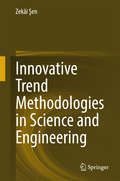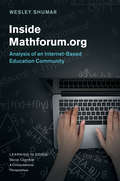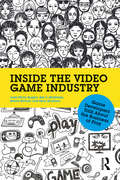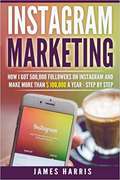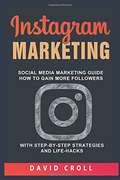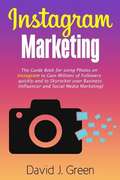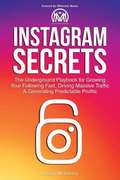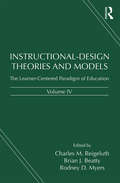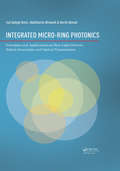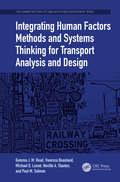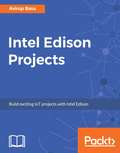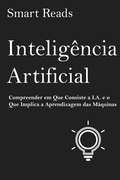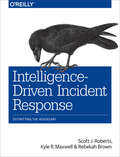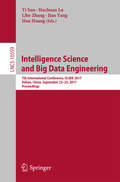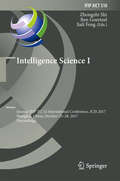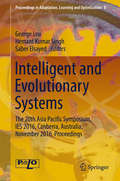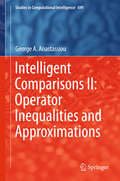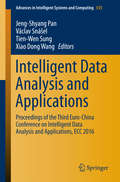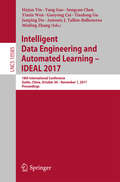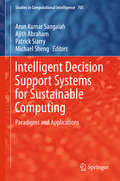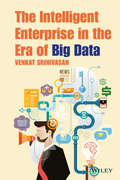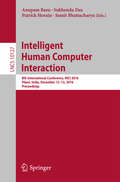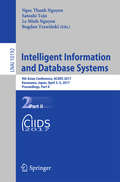- Table View
- List View
Innovative Trend Methodologies in Science and Engineering
by Zekâi ŞenThis book covers all types of literature on existing trend analysis approaches, but more than 60% of the methodologies are developed here and some of them are reflected to scientific literature and others are also innovative versions, modifications or improvements. The suggested methodologies help to design, develop, manage and deliver scientific applications and training to meet the needs of interested staff in companies, industries and universities including students.Technical content and expertise are also provided from different theoretical and especially active roles in the design, development and delivery of science in particular and economics and business in general. It is also ensured that, wherever possible and technically appropriate, priority is given to the inclusion and integration of real life data, examples and processes within the book content.The time seems right, because available books just focus on special sectors (fashion, social, business). This book reviews all the available trend approaches in the present literature on rational and logical bases.
Inside Mathforum.org: Analysis of an Internet-Based Education Community (Learning in Doing: Social, Cognitive and Computational Perspectives)
by Wesley ShumarThe internet has dramatically transformed social space and time for many people in many different contexts. This dramatic warping of the social fabric has happened slowly over time as digital technologies have evolved and internet speeds have increased. While we are all aware of these changes, the impact is often little understood. There are few monographs about social groups made possible by the internet, and even fewer about educational communities made possible through digital technologies. Inside Mathforum. org details the ways that digital media are used to enhance the practices that teachers and students of mathematics engage in. The book also shows how different kinds of mathematical conversations and interactions become possible through the digital media. Unlike many other educational uses of digital media, the Math Forum's community has provided online resources and sustained support for teachers and students, and it leads the way in showing the power of digital media for education.
Inside the Video Game Industry: Game Developers Talk About the Business of Play
by Judd Ruggill Ken McAllister Randy Nichols Ryan KaufmanInside the Video Game Industry offers a provocative look into one of today's most dynamic and creative businesses. Through in-depth structured interviews, industry professionals discuss their roles, providing invaluable insight into game programming, art, animation, design, production, quality assurance, audio and business professions. From hiring and firing conventions, attitudes about gender disparity, goals for work-life balance, and a span of legal, psychological, and communal intellectual property protection mechanisms, the book's combination of accessible industry talk and incisive thematic overviews is ideal for anyone interested in games as a global industry, a site of cultural study, or a prospective career path. Designed for researchers, educators, and students, this book provides a critical perspective on an often opaque business and its highly mobile workforce. Additional teaching materials, including activities and study questions, can be found at https://www.routledge.com/9780415828284.
Instagram Marketing: How I got 500,000 Followers on Instagram and Make More than $100,000 a Year - Step by Step
by James HarrisAre you having problems breaking out into the world of marketing? Do you have a lack of marketing funds, but still want to reach a lot of people? Are you just wanting a way to market to people even when you are not able to go door to door? <p><p> If you answered yes to any of these questions, then you are in need of this book. In these pages, you will find information about the world's most popular photo sharing social media site, Instagram, and how to utilize it for your own marketing purposes.
Instagram Marketing: Social Media Marketing Guide: How to Gain More Followers With Step-by-Step Strategies and Life-Hacks
by David CrollSome of the most effective, intensive, and mathematically verified strategies to simply grow your Instagram blog.
Instagram Marketing: The Guide Book for Using Photos on Instagram to Gain Millions of Followers Quickly and to Skyrocket your Business (Influencer and Social Media Marketing)
by David Green<p>Instagram has 800 million users! <p>Instagram is one of the largest social media platforms that you definitely want to be using! <p>Topics Included in this Book: <p> <li>How you can better prepare for the Challenges of Using Instagram <li>The Benefits of Using Instagram for Business <li>What You Can Learn from Other Popular Instagram Accounts <li>How to Create an Effective Instagram Marketing Strategy <li>Factors that Affect the Visibility of Your Instagram Posts <li>The Top Instagram Ideas You Must Know</li> </p>
Instagram Secrets: The Underground Playbook for Growing Your Following Fast, Driving Massive Traffic and Generating Predictable Profits
by Jeremy Mcgilvrey<p>Instagram Secrets is NOT a book about getting likes and comments or which hashtags to use. Instead, the information found inside of the 21 chapters lays out a step-by-step formula for the two things online entrepreneurs care about most: <p> <li>1. Building a large following FAST. <li>2. Converting those followers into DOLLARS. </li> <p> <p>The old way of being successful on social media meant that you had to spend a small fortune to build your following, then light your marketing dollars on fire trying to figure out Facebook ads. <p>Instagram Secrets completely demolishes the old way entrepreneurs were taught to use social media to grow their businesses. Now, anybody (even if you have ZERO Instagram followers) can generate an ENDLESS FLOOD of warm, cheap and targeted leads on demand. The warmer the lead, the easier the sale. The cheaper the lead, the higher the profit. </p>
Instructional-Design Theories and Models, Volume IV: The Learner-Centered Paradigm of Education
by Charles M. Reigeluth, Brian J. Beatty, and Rodney D. MyersInstructional-Design Theories and Models, Volume IV provides a research-based description of the current state of instructional theory for the learner-centered paradigm of education, as well as a clear indication of how different theories and models interrelate. Significant changes have occurred in learning and instructional theory since the publication of Volume III, including advances in brain-based learning, learning sciences, information technologies, internet-based communication, a concern for customizing the student experience to maximize effectiveness, and scaling instructional environments to maximize efficiency. In order to complement the themes of Volume I (commonality and complementarity among theories of instruction), Volume II (diversity of theories) and Volume III (building a common knowledge base), the theme of Volume IV is shifting the paradigm of instruction from teacher-centered to learner-centered and integrating design theories of instruction, assessment, and curriculum. Chapters in Volume IV are collected into three primary sections: a comprehensive view of the learner-centered paradigm of education and training, elaborations on parts of that view for a variety of K-12 and higher education settings, and theories that address ways to move toward the learner-centered paradigm within the teacher-centered paradigm. Instructional-Design Theories and Models, Volume IV is an essential book for anyone interested in exploring more powerful ways of fostering human learning and development and thinking creatively about ways to best meet the needs of learners in all kinds of learning contexts.
Instructional-Design Theories and Models, Volume IV: The Learner-Centered Paradigm of Education
by Charles M. Reigeluth, Brian J. Beatty, and Rodney D. MyersInstructional-Design Theories and Models, Volume IV provides a research-based description of the current state of instructional theory for the learner-centered paradigm of education, as well as a clear indication of how different theories and models interrelate. Significant changes have occurred in learning and instructional theory since the publication of Volume III, including advances in brain-based learning, learning sciences, information technologies, internet-based communication, a concern for customizing the student experience to maximize effectiveness, and scaling instructional environments to maximize efficiency.In order to complement the themes of Volume I (commonality and complementarity among theories of instruction), Volume II (diversity of theories) and Volume III (building a common knowledge base), the theme of Volume IV is shifting the paradigm of instruction from teacher-centered to learner-centered and integrating design theories of instruction, assessment, and curriculum. Chapters in Volume IV are collected into three primary sections: a comprehensive view of the learner-centered paradigm of education and training, elaborations on parts of that view for a variety of K-12 and higher education settings, and theories that address ways to move toward the learner-centered paradigm within the teacher-centered paradigm. Instructional-Design Theories and Models, Volume IV is an essential book for anyone interested in exploring more powerful ways of fostering human learning and development and thinking creatively about ways to best meet the needs of learners in all kinds of learning contexts.
Integrated Micro-Ring Photonics: Principles and Applications as Slow Light Devices, Soliton Generation and Optical Transmission
by Iraj Sadegh Amiri Abdolkarim Afroozeh Harith AhmadMicro-ring resonators (MRRs) are employed to generate signals used for optical communication applications, where they can be integrated in a single system. These structures are ideal candidates for very large-scale integrated (VLSI) photonic circuits, since they provide a wide range of optical signal processing functions while being ultra-compact. Soliton pulses have sufficient stability for preservation of their shape and velocity. Technological progress in fields such as tunable narrow band laser systems, multiple transmission, and MRR systems constitute a base for the development of new transmission techniques. Controlling the speed of a light signal has many potential applications in fiber optic communication and quantum computing. The slow light effect has many important applications and is a key technology for all optical networks such as optical signal processing. Generation of slow light in MRRs is based on the nonlinear optical fibers. Slow light can be generated within the micro-ring devices, which will be able to be used with the mobile telephone. Therefore, the message can be kept encrypted via quantum cryptography. Thus perfect security in a mobile telephone network is plausible. This research study involves both numerical experiments and theoretical work based on MRRs for secured communication.
Integrating Human Factors Methods and Systems Thinking for Transport Analysis and Design (The Human Factors, Simulation and Performance Assessment Series)
by Gemma J. Read Vanessa Beanland Michael G. Lenné Neville A. Stanton Paul M. SalmonGovernments and road safety agencies around the world have either introduced or are considering 'safe system' strategies, a long overdue acknowledgement that different elements of the road system contribute to road safety outcomes. Human factors approaches have a leading role here in both conceptualising the road system as a complex sociotechnical system and in providing practical approaches to support true systems-based countermeasures. This book illustrates the potential for integrating contemporary systems-based human factors methods with modern day driving-assessment methods, such as vehicle instrumentation and driving simulation, to understand and enhance performance in modern day road-transport systems. The book outlines why a fundamental paradigm shift is needed in the way these systems are designed and operated, and illustrates how a wide range of accepted human-factors approaches can be applied successfully to road transport to revolutionise the countermeasure design process. The practical illustrations of these human factors methods are applied to a long-standing road and rail safety issue: rail level crossings, where the road and rail systems intersect. The final chapter of the book highlights the utility of the human factors approach to reducing road trauma and discusses future applications of the approach.
Intel Edison Projects
by Avirup BasuBuild powerful Robots and IoT solutions using Intel Edison About This Book • Learn to build advanced level robots with Intel Edison and Arduino • Efficiently build and program home automation and IoT projects with Intel Edison • Master the skills of creating enticing projects with Intel Edison. Who This Book Is For If you are a hobbyist, robot engineer, IoT enthusiast, programmer, or developer who wants to create autonomous projects with Intel Edison, then this book is for you. Prior programming knowledge would be beneficial. What You Will Learn • Program your device using the Arduino processor language, Python, and Node.js • Interface different sensors with the Intel Edison • Build a home automation system using MQTT, Android, and WPF • Perform face detection using Intel Edison • Develop a high-speed line follower robot • Control a robot using a PC application and an custom controller In Detail Change the way you look at embedded electronics with Intel Edison. It is a small computing platform packed with a set of robust features to deliver hands-on performance, durability, and software support. This book is a perfect place to kickstart development and rapid prototyping using Intel Edison. It will start by introducing readers to the Intel Edison board and explaining how to get started with it. You will learn how to build a mini weather station, which will help you to acquire temperature and smoke level and push it to the IoT platform. Then you will see how to build a home automation device and control your appliances using an Android app. Furthermore, we will build a security system using a webcam to detect faces and perform voice recognition. Toward the end, the book will demonstrate how you can build two robots, which will be based on different line sensing sensors and can be controlled by a PC. The book will guide the readers through each and every step of execution of a project, using Intel Edison. Style and approach A project-based guide that will take the readers through various domains of projects like robotics, IoT and so on.
Inteligência Artificial
by Patrícia Pinto Smart ReadsOs Empreendedores Elon Musk, Stephen Hawking e Bill Gates, proclamaram a Inteligência Artificial como uma possível ameaça no futuro, caso o Homem não faça uso desta tecnologia com sabedoria. Será verdade? Será possível criar, muito em breve, uma programação que dê um raciocínio e emoções aos dispositivos da Inteligência Artificial? Será, até mesmo, possível termos um candidato tipo-humano, projetado pela I.A, a concorrer às eleiçóes presidênciais no futuro? Estas são as questões e ideologias a ser abordadas no âmbito da I.A e foram aprofundadas no livro: “Inteligência Artificial: Compreender Em Que Consiste a I. A. e O Que Implica a Aprendizagem Das Máquinas”. Este livro foi elaborado de forma a dar uma visão geral e concisa acerca dos temas relacionados com o início da Era das ‘máquinas inteligentes’ e sobre a nossa abordagem atual dos tempos moderna, assim como o impacto das novas tecnologias no futuro e na existência da humanidade. Género: COMPUTADORES / Processamento de Dados Género Secundário: NEGÓCIOS & ECONOMIA / Geral. Línguas: Inglês, Português, outras versões poderão estar disponíveis. Palavras-chave: Inteligência Artificial, I.A, Aprendizagem das Máquinas, a Inteligência das Máquinas, Tecnologias, Avanços Tecnológicos, Computação, Automatização. Número de páginas: 42.
Intelligence-Driven Incident Response: Outwitting the Adversary
by Rebekah Brown Scott J RobertsUsing a well-conceived incident response plan in the aftermath of an online security breach enables your team to identify attackers and learn how they operate. But, only when you approach incident response with a cyber threat intelligence mindset will you truly understand the value of that information. With this practical guide, you’ll learn the fundamentals of intelligence analysis, as well as the best ways to incorporate these techniques into your incident response process.Each method reinforces the other: threat intelligence supports and augments incident response, while incident response generates useful threat intelligence. This book helps incident managers, malware analysts, reverse engineers, digital forensics specialists, and intelligence analysts understand, implement, and benefit from this relationship.In three parts, this in-depth book includes:The fundamentals: get an introduction to cyber threat intelligence, the intelligence process, the incident-response process, and how they all work togetherPractical application: walk through the intelligence-driven incident response (IDIR) process using the F3EAD process—Find, Fix Finish, Exploit, Analyze, and DisseminateThe way forward: explore big-picture aspects of IDIR that go beyond individual incident-response investigations, including intelligence team building
An Intelligence in Our Image: The Risks of Bias and Errors in Artificial Intelligence
by Osonde A. Osoba William Welser IvMachine learning algorithms and artificial intelligence influence many aspects of life today and have gained an aura of objectivity and infallibility. The use of these tools introduces a new level of risk and complexity in policy. This report illustrates some of the shortcomings of algorithmic decisionmaking, identifies key themes around the problem of algorithmic errors and bias, and examines some approaches for combating these problems.
Intelligence Science and Big Data Engineering: 7th International Conference, IScIDE 2017, Dalian, China, September 22-23, 2017, Proceedings (Lecture Notes in Computer Science #10559)
by Yi Sun, Huchuan Lu, Lihe Zhang, Jian Yang and Hua HuangThis book constitutes the proceedings of the 7th International Conference on Intelligence Science and Big Data Engineering, IScIDE 2017, held in Dalian, China, in September 2017.The 48 full papers and 14 short papers presented in this volume were carefully reviewed and selected from 121 submissions. They deal with statistics and learning; deep neural networks; faces and people; objects; classification and clustering; imaging; biomedical signal processing; and recommendation.
Intelligence Science I: Second IFIP TC 12 International Conference, ICIS 2017, Shanghai, China, October 25-28, 2017, Proceedings (IFIP Advances in Information and Communication Technology #510)
by Zhongzhi Shi, Ben Goertzel and Jiali FengThis book constitutes the refereed proceedings of the Second International Conference on Intelligence Science, ICIS 2017, held in Shanghai, China, in October 2017.The 38 full papers and 9 short papers presented were carefully reviewed and selected from 82 submissions. They deal with key issues in intelligence science and have been organized in the following topical sections: theory of intelligence science; cognitive computing; big data analysis and machine learning; machine perception; intelligent information processing; and intelligent applications.
Intelligent and Evolutionary Systems
by George Leu Hemant Kumar Singh Saber ElsayedOver the last two decades the field of Intelligent Systems delivered to human kind significant achievements, while also facing major transformations. 20 years ago, automation and knowledge-based AI were still the dominant paradigms fueling the efforts of both researchers and practitioners. Later, 10 years ago, statistical machine intelligence was on the rise, heavily supported by the digital computing, and led to the unprecedented advances in and dependence on digital technology. However, the resultant intelligent systems remained designer-based endeavors and thus, were limited in their true learning and development abilities. Today, the challenge is to have in place intelligent systems that can develop themselves on behalf of their creators, and gain abilities with no or limited supervision in the tasks they are meant to perform. Cognitive development systems, and the supporting cognitive computing are on the rise today, promising yet other significant achievements for the future of human kind. This book captures this unprecedented evolution of the field of intelligent systems, presenting a compilation of studies that covers all research directions in the field over the last two decades, offering to the reader a broad view over the field, while providing a solid foundation from which outstanding new ideas may emerge.
Intelligent Comparisons II: Operator Inequalities and Approximations
by George A. AnastassiouThis compact book focuses on self-adjoint operators' well-known named inequalities and Korovkin approximation theory, both in a Hilbert space environment. It is the first book to study these aspects, and all chapters are self-contained and can be read independently. Further, each chapter includes an extensive list of references for further reading. The book's results are expected to find applications in many areas of pure and applied mathematics. Given its concise format, it is especially suitable for use in related graduate classes and research projects. As such, the book offers a valuable resource for researchers and graduate students alike, as well as a key addition to all science and engineering libraries.
Intelligent Data Analysis and Applications
by Jeng-Shyang Pan Václav Snášel Tien-Wen Sung Xiao Dong WangThis book gathers papers presented at the ECC 2016, the Third Euro-China Conference on Intelligent Data Analysis and Applications, which was held in Fuzhou City, China from November 7 to 9, 2016. The aim of the ECC is to provide an internationally respected forum for scientific research in the broad areas of intelligent data analysis, computational intelligence, signal processing, and all associated applications of artificial intelligence (AI). The third installment of the ECC was jointly organized by Fujian University of Technology, China, and VSB-Technical University of Ostrava, Czech Republic. The conference was co-sponsored by Taiwan Association for Web Intelligence Consortium, and Immersion Co. , Ltd.
Intelligent Data Engineering and Automated Learning – IDEAL 2017: 18th International Conference, Guilin, China, October 30 – November 1, 2017, Proceedings (Lecture Notes in Computer Science #10585)
by Hujun Yin, Yang Gao, Songcan Chen, Yimin Wen, Guoyong Cai, Tianlong Gu, Junping Du, Antonio J. Tallón-Ballesteros and Minling ZhangThis book constitutes the refereed proceedings of the 18th International Conference on Intelligent Data Engineering and Automated Learning, IDEAL 2017, held in Guilin, China, in October/November 2017.The 65 full papers presented were carefully reviewed and selected from 110 submissions. These papers provided a sample of latest research outcomes in data engineering and automated learning, from methodologies, frameworks and techniques to applications. In addition to various topics such as evolutionary algorithms, deep learning neural networks, probabilistic modelling, particle swarm intelligence, big data analytics, and applications in image recognition, regression, classification, clustering, medical and biological modelling and prediction, text processing and social media analysis.
Intelligent Decision Support Systems for Sustainable Computing
by Arun Kumar Sangaiah Ajith Abraham Patrick Siarry Michael ShengThis unique book dicusses the latest research, innovative ideas, challenges and computational intelligence (CI) solutions in sustainable computing. It presents novel, in-depth fundamental research on achieving a sustainable lifestyle for society, either from a methodological or from an application perspective. Sustainable computing has expanded to become a significant research area covering the fields of computer science and engineering, electrical engineering and other engineering disciplines, and there has been an increase in the amount of literature on aspects sustainable computing such as energy efficiency and natural resources conservation that emphasizes the role of ICT (information and communications technology) in achieving system design and operation objectives. The energy impact/design of more efficient IT infrastructures is a key challenge in realizing new computing paradigms. The book explores the uses of computational intelligence (CI) techniques for intelligent decision support that can be exploited to create effectual computing systems, and addresses sustainability problems in computing and information processing environments and technologies at the different levels of CI paradigms. An excellent guide to surveying the state of the art in computational intelligence applied to challenging real-world problems in sustainable computing, it is intended for scientists, practitioners, researchers and academicians dealing with the new challenges and advances in area.
The Intelligent Enterprise in the Era of Big Data
by Venkat SrinivasanAn innovative guide to the organization and function of enterprises in the technological age In the era of big data and automation, this book presents a cutting-edge approach in how enterprises should organize and function. Striking a practical balance between theory and practice, The Intelligent Enterprise in the Era of Big Data presents an enterprise architecture that embodies the power of the emerging technology environment. Beginning with an introduction to the key challenges that enterprises face, the book systematically outlines a modern enterprise architecture through a detailed discussion of the inseparable elements of such an architecture: efficiency, flexibility, and intelligence. This architecture enables rapid responses to market needs by facilitating intelligent, flexible automation of enterprise business processes and sensing important developments in internal and external environments in near real time. Illustrating all of these elements in an integrated fashion, The Intelligent Enterprise in the Era of Big Data also features: A detailed discussion on issues of time-to-market and flexibility with respect to enterprise application technology Novel analyses illustrated through extensive real-world case studies to help readers better understand the applicability of the architecture and concepts Practical approaches for designing and building intelligent enterprises An appendix that presents various approaches to text analysis with real-world business implications The Intelligent Enterprise in the Era of Big Data is an appropriate reference for business executives, information technology professionals, data scientists, and management consultants.
Intelligent Human Computer Interaction
by Anupam Basu Sukhendu Das Patrick Horain Samit BhattacharyaThis book constitutes the proceedings of the 8th International Conference on Intelligent Human Computer Interaction, IHCI 2016, held in Pilani, India, in December 2016. The 22 regular papers and 3 abstracts of invited talks included in this volume were carefully reviewed and selected from 115 initial submissions. They deal with intelligent interfaces; brain machine interaction; HCI applications and technology; and interface and systems.
Intelligent Information and Database Systems: 9th Asian Conference, ACIIDS 2017, Kanazawa, Japan, April 3–5, 2017, Proceedings, Part II (Lecture Notes in Computer Science #10192)
by Ngoc Thanh Nguyen, Satoshi Tojo, Le Minh Nguyen and Bogdan TrawińskiThe two-volume set LNAI 10191 and 10192 constitutes the refereed proceedings of the 9th Asian Conference on Intelligent Information and Database Systems, ACIIDS 2017, held in Kanazawa, Japan, in April 2017. The total of 152 full papers accepted for publication in these proceedings was carefully reviewed and selected from 420 submissions. They were organized in topical sections named: Knowledge Engineering and Semantic Web; Social Networks and Recommender Systems; Text Processing and Information Retrieval; Intelligent Database Systems; Intelligent Information Systems; Decision Support and Control Systems; Machine Learning and Data Mining; Computer Vision Techniques; Advanced Data Mining Techniques and Applications; Intelligent and Context Systems; Multiple Model Approach to Machine Learning; Applications of Data Science; Artificial Intelligence Applications for E-services; Automated Reasoning and Proving Techniques with Applications in Intelligent Systems; Collective Intelligence for Service Innovation, Technology Opportunity, E-Learning and Fuzzy Intelligent Systems; Intelligent Computer Vision Systems and Applications; Intelligent Data Analysis, Applications and Technologies for Internet of Things; Intelligent Algorithms and Brain Functions; Intelligent Systems and Algorithms in Information Sciences; IT in Biomedicine; Intelligent Technologies in the Smart Cities in the 21st Century; Analysis of Image, Video and Motion Data in Life Sciences; Modern Applications of Machine Learning for Actionable Knowledge Extraction; Mathematics of Decision Sciences and Information Science; Scalable Data Analysis in Bioinformatics and Biomedical Informatics; and Technological Perspective of Agile Transformation in IT organizations.
